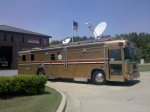A couple of weeks ago, we had an unusual incident. An emergency aircraft beacon (121.5 mHz) was reported in Columbus, GA. I don't know who originally picked up the signal but the Civil Air Patrol was called in to try to pin it down. It turned out to be located in a residential area. I handle communications for a regional interstate search and rescue group. We handle high-angle rescue, water and trench rescue, collapsed building, etc. We're equipped with side-scan sonar for water rescues and even seismic equipment for collapsed buildings.
We have a mobile command post that responds to many of these incidents. It has VHF, UHF, 700 mHz, 800 mHz, aircraft, marine, ham, etc. Some of the radios are programmable. We quickly decided that if an aircraft went down in a residential area, someone would certainly know about it. So, realizing it was apparently not an emergency, minimum manpower was used and the command post remained garaged. The neighborhood was an older, well-established middle-class area with a couple of churches, a vocational high school, etc., nothing unusual.
The search & rescue unit has no directional equipment but the CAP did have RDF with a “bow-tie” antenna. We had an Icom A6 aircraft portable. Moving through the neighborhood, it was almost impossible to locate the origin of the signal because it was too strong. (Under emergency circumstances, a downed aircraft would be pretty easy to spot in a residential area.) Even though no crash was involved the radio had to be located and silenced. The CAP took their RDF and started walking through the neighborhood. They even went door-to-door asking about anything unusual in the neighborhood or whether anyone knew of a pilot who lived in the area. No luck.
Our biggest problem was the fact that the signal was so strong it couldn't be pin-pointed. We decided to “dumb down” the equipment so it would have more trouble picking up the signal. I had an idea that actually worked. I got a couple of wire ties like you get on loaves of bread, stripped the plastic off the ends and tied them together I removed the antenna from the Icom. One end of the new make-shift “antenna” was inserted into the Icom antenna connection. I held the radio against my body and I slowly turned in a circle. My body blocked the signal when it was directly behind me. After several rotations, we pin-pointed the signal as coming from the back of the high school.
CAP went to the school and found the signal. It seems someone donated an aircraft frame to the school and the emergency beacon was left intact. While the students were doing whatever vocational high school students do with aircraft frames, the beacon was activated. CAP took custody of it. The aircraft was not visible from the street.
Maybe sometimes, you can have too much technology.
We have a mobile command post that responds to many of these incidents. It has VHF, UHF, 700 mHz, 800 mHz, aircraft, marine, ham, etc. Some of the radios are programmable. We quickly decided that if an aircraft went down in a residential area, someone would certainly know about it. So, realizing it was apparently not an emergency, minimum manpower was used and the command post remained garaged. The neighborhood was an older, well-established middle-class area with a couple of churches, a vocational high school, etc., nothing unusual.
The search & rescue unit has no directional equipment but the CAP did have RDF with a “bow-tie” antenna. We had an Icom A6 aircraft portable. Moving through the neighborhood, it was almost impossible to locate the origin of the signal because it was too strong. (Under emergency circumstances, a downed aircraft would be pretty easy to spot in a residential area.) Even though no crash was involved the radio had to be located and silenced. The CAP took their RDF and started walking through the neighborhood. They even went door-to-door asking about anything unusual in the neighborhood or whether anyone knew of a pilot who lived in the area. No luck.
Our biggest problem was the fact that the signal was so strong it couldn't be pin-pointed. We decided to “dumb down” the equipment so it would have more trouble picking up the signal. I had an idea that actually worked. I got a couple of wire ties like you get on loaves of bread, stripped the plastic off the ends and tied them together I removed the antenna from the Icom. One end of the new make-shift “antenna” was inserted into the Icom antenna connection. I held the radio against my body and I slowly turned in a circle. My body blocked the signal when it was directly behind me. After several rotations, we pin-pointed the signal as coming from the back of the high school.
CAP went to the school and found the signal. It seems someone donated an aircraft frame to the school and the emergency beacon was left intact. While the students were doing whatever vocational high school students do with aircraft frames, the beacon was activated. CAP took custody of it. The aircraft was not visible from the street.
Maybe sometimes, you can have too much technology.


